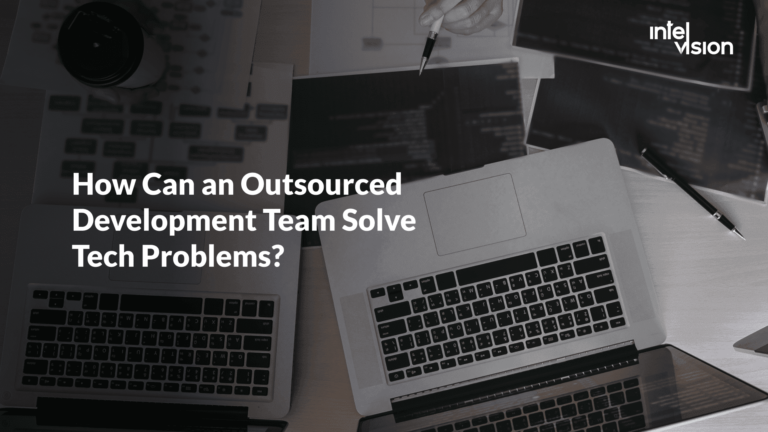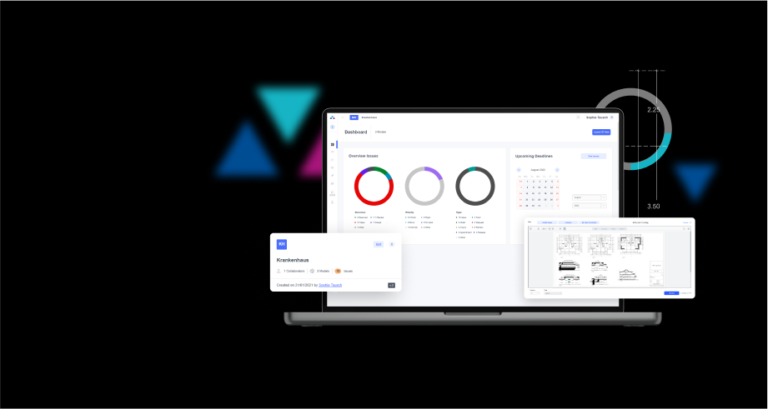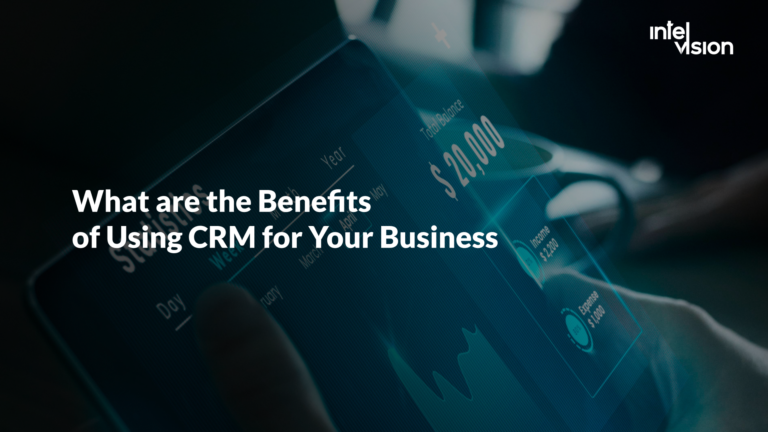
What are the Benefits of Using CRM for Your Business
Attracting a new customer is 5–10 times more expensive than selling a product to a regular one. Moreover, permanent clients spend 67% more than new ones. Therefore, a modern business cannot develop without building long-term relationships with existing customers. After all, it’s impossible to increase the customer base indefinitely without retaining profitable, valuable, and loyal customers. It’s like a leaky bucket that won’t hold water no matter how much it is.
We’ve shared all you need to know about the benefits of CRM, as well as useful cases that will demonstrate how the software will help your company make money more effectively.
What is CRM and Why Is It Important
Customer relationship management (CRM) is a technology for managing all your company’s relationships and interactions with existing customers and potential loyal customers. A CRM system helps keep track of customer data and provides insight into the target audience, from contact details to sales history and customer relationships. For example, in the French shopping club Vente-privee, staff take into account what time and what device customers use. This helps to contact the client in a convenient channel and formulate the offer efficiently.
The main goal of a CRM strategy is to create a flow of new customers and engage existing ones. The main function is to help managers plan sales, manage transactions transparently and sell effectively.
The CRM platform also includes tools aimed at returning and retaining customers. With the help of analytics, you can predict which clients may leave you and how fast is it going to happen.
Top Benefits of a CRM System for the Business
With the help of the CRM platform, the conversion can increase up to four times. According to IBM, every dollar invested in the implementation of CRM solutions brings the company five dollars in profit. This alone demonstrates the CRM benefits and the importance of using this system.
What are the benefits of CRM? We have distinguished the following benefits of CRM for your business:
- Useful analytics. The CRM platform will show the results of the company’s work—this will help to analyze the sales funnel and understand which channels work more efficiently.
- Integration with third-party services. This helps increase the versatility of CRM solutions by expanding their capabilities.
- Simple reporting. Nobody likes to fill out reports. But this is not required when a CRM is installed. The program will create the necessary report in a couple of seconds, objectively showing the data.
- Storing the history of interactions with the client. That’s one of the key CRM benefits. Even a new manager who has just joined the company will be able to quickly adapt—all the data on applications left by customers will be at his disposal.
The article does not list all the advantages of a CRM system. Everyone will be able to find their positive aspects from its implementation.
How CRM Helps Sell: Two Case Studies Across the Industries
With the CRM platform, you get to know your customers, you can choose a certain segment and make an offer so they cannot refuse. Personal offers work great when it comes to developing, retaining, and returning customers. We will show you how with examples.
Supermarket. Strategy—Customer Development
In the grocery retail market, the customer chooses from 4–6 stores that he/she visits every month. These stores compete for a share of the shopping cart. Many people buy cheese and wine in different shops. If one of them offers people both of the products, they will earn more.
You work with a buyers database, and analyze what they usually buy and what offer they are interested in.
You are interested in repeat customers:
- they live or work nearby;
- everyone has a set of favorite products and the regularity of their purchase;
- they spend at least 20% of the total budget on food and drinks;
- if customers receive a message about a discount on their favorite products, the likelihood of purchase will increase by 5%;
- coming to the store for one category, they’ll most likely buy others too.
An example of working with a buyer based on the insights from CRM
For example, there are 100,000 such customers in a store, which is the “Friday Wine Drinkers” segment. Perhaps they buy wine more often, but they do it in other stores. Send an email to buyers in this category.
Subject: Discount on your favorite wine
Hello Lauren!
We’ve noticed you bought Pinot Grigio del Veneto in our store the previous time. We offer you a 20% discount on your next purchase of two bottles of wine. We just brought in new Italian white dry.
We are looking forward to seeing you in our store again!
Sincerely,
Goodwine
If at least 5% of 100,000 customers respond to the offer, you will sell 5,000 bottles for $50,000.
Clothing store. Strategy—Customer Retention
The clothing market is highly competitive: there is a chance that a repeat customer will go to another store. Then you will lose not only the amount of the regular purchase but also the profit from the following ones.
The current and future value of such a buyer is great—you need to keep him. By solving the choice problem, the store increases the chances that the buyer will not switch to a competitor. It is easier and cheaper to retain a valuable customer than to attract him again.
The most valuable for us are highly profitable buyers:
- they have established preferences in clothing;
- someone buys once a year for $800 in a store, someone—once a month for small amounts on the website;
- they left contact details in exchange for a discount card;
- every time they are going to buy new clothes, they face a choice— to go back to you or other stores.
An example of working with a buyer based on the insights from CRM
For example, there are 5000 such customers in the store, and every year you lose 10% of them. Because of this outflow, you will more likely lose $ 2.2 million over 3 years.
For each client, prepare an individual offer of clothing models. Offer to save time and order online, send a promo code for free shipping. Or sign up in a boutique where a personal consultant will select models in advance. Send an offer by email 1–2 weeks before the proposed purchase.
Subject: Already selected blouses for you
Bonjour Olivia!
We remember you usually revamp your wardrobe in October.
We have already selected for you organic cotton blouses in size S in white and pink colors—as you always buy.
Order them online with free delivery or write when it is convenient for you to come to the store —the consultant will prepare several options in advance so that you do not have to wait.
Thank you for choosing Chloé!
From 120 to 150 customers will respond to the proposal due to attention to their needs. The outflow will be reduced by 3%, and this will allow “saving” 672 thousand dollars over 3 years.
Check Out Do You Need a CRM Software
CRM solutions are indispensable for solving several groups of tasks that are relevant for all companies, the profitability of which directly depends on successful interaction with customers. Let’s take a look through the main sectors:
- Sales management. CRM software allows you to ensure that the client receives a quality product or service on time, as well as to avoid problems associated with the human factor, and plan further steps in working with clients.
- Marketing management. The advantages of a CRM system are the ability to fully automate work with clients, carry out market research, analyze received data, collect a database of potential customers, identify their needs, and form a proper strategy and marketing campaigns.
- Interaction management. Storage and quick access to all information about customers, their contacts, purchase history, conversation records, and correspondence is another important advantage of CRM software.
- Service management. All issues related to obtaining the necessary information from the customer about the parameters of the order, organizing delivery, and payment can also be automated thanks to CRM.
At the same time, if you have less than a thousand customers, it makes no sense to implement CRM software. Imagine a baker who sells the best pastries in the city. The fact that he stands behind the counter and offers his product already makes it valuable to customers. To be successful, he doesn’t need customer relationship management and sophisticated analytics. It’s enough to know his clients, and their preferences as well as to create the right product.
But this approach doesn’t apply to everyone. We advise companies with more than ten thousand customers to start implementing CRM, especially if there is a need to automate processes, track customer activity, and use data analytics.
How to Implement CRM Software Without the Frustration
The decision to implement CRM solutions just because it’s a trend is one of the reasons that “destroys” 90% of projects. It sounds strange, but the situation looks like this: the client attended a workshop or a presentation on some customer relationship management systems. The lecturer showed some features. The client liked it—and he turned to the software development company with a request to immediately introduce this particular feature. However, there is no clear answer to the questions:
- Why does he need this feature?
- How to correctly calculate the profitability of this feature for your business, based on your indicators?
- Why does the customer consider this feature to be key?
Seeing that the efficiency has not increased, the client will decide that CRM solutions “don’t work”, although he was promised the opposite. Therefore, the main risks in CRM software implementation are:
- wrong choice of components for implementation, which can lead to financial losses and the purchase of “unnecessary” options;
- technological risk—the compatibility of the approaches and technologies used with the platform or service for CRM solutions that you’ve chosen;
- the risk of sabotage, which turns into the dismissal of the sales team and the transition to a competitor. Because a competitor, for example, is not forced to fill out customer satisfaction indicators.
Determine why you need CRM, and what are the benefits of CRM for your business. Don’t forget: the answer must contain money. For example: “I lose 20 orders a week because the sales department doesn’t call back. In monetary terms, this is too much. After the implementation of the CRM system, we won’t have these losses.”
Then determine the key changes that CRM should bring. For example: “We need the system to turn missed calls into tasks and make sure the call back is made within 30 minutes.”
Reach Your CRM Software Development Goals with Intelvision
Six reasons to work with us:
- More than 40 projects completed in 4+ years on the market.
- 20+ IT specialists—experts in their field, fast and forever learners. Our team constantly improves its craft because the world isn’t sitting around, watching reruns of ‘Friends.’
- We are recommended by past and current clients.
- Domain knowledge. Our experts dive deeply into every sector where our clients operate or plan to launch a business.
- Technological expertise. We are technology enthusiasts and work only with middle+ specialists.
- Rapid implementation. From agile to DevOps to continuous delivery, we use modern development approaches to work better, faster, and more transparent.
Let’s talk! Just enter your details and we will reply within 24 hours.









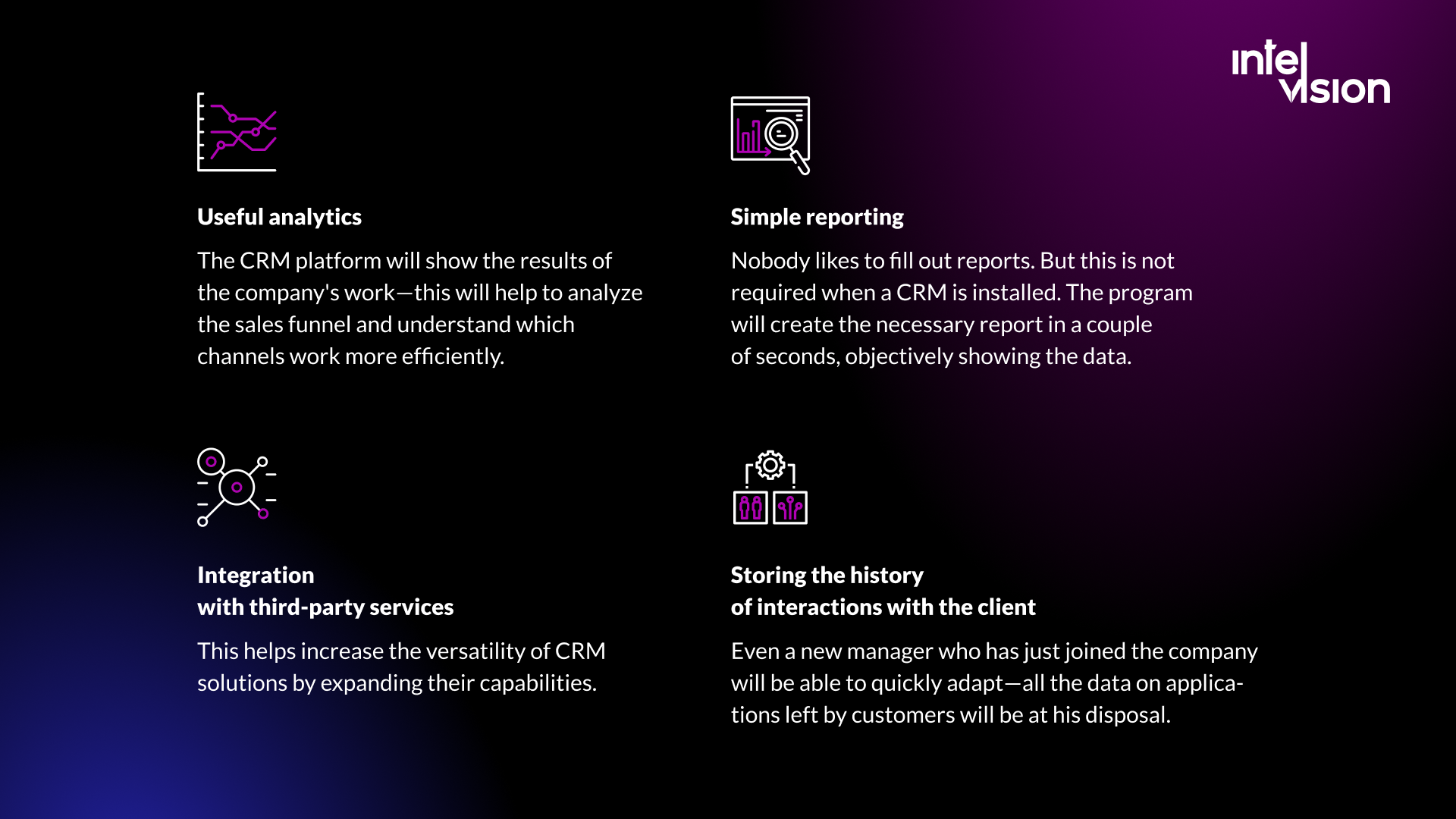
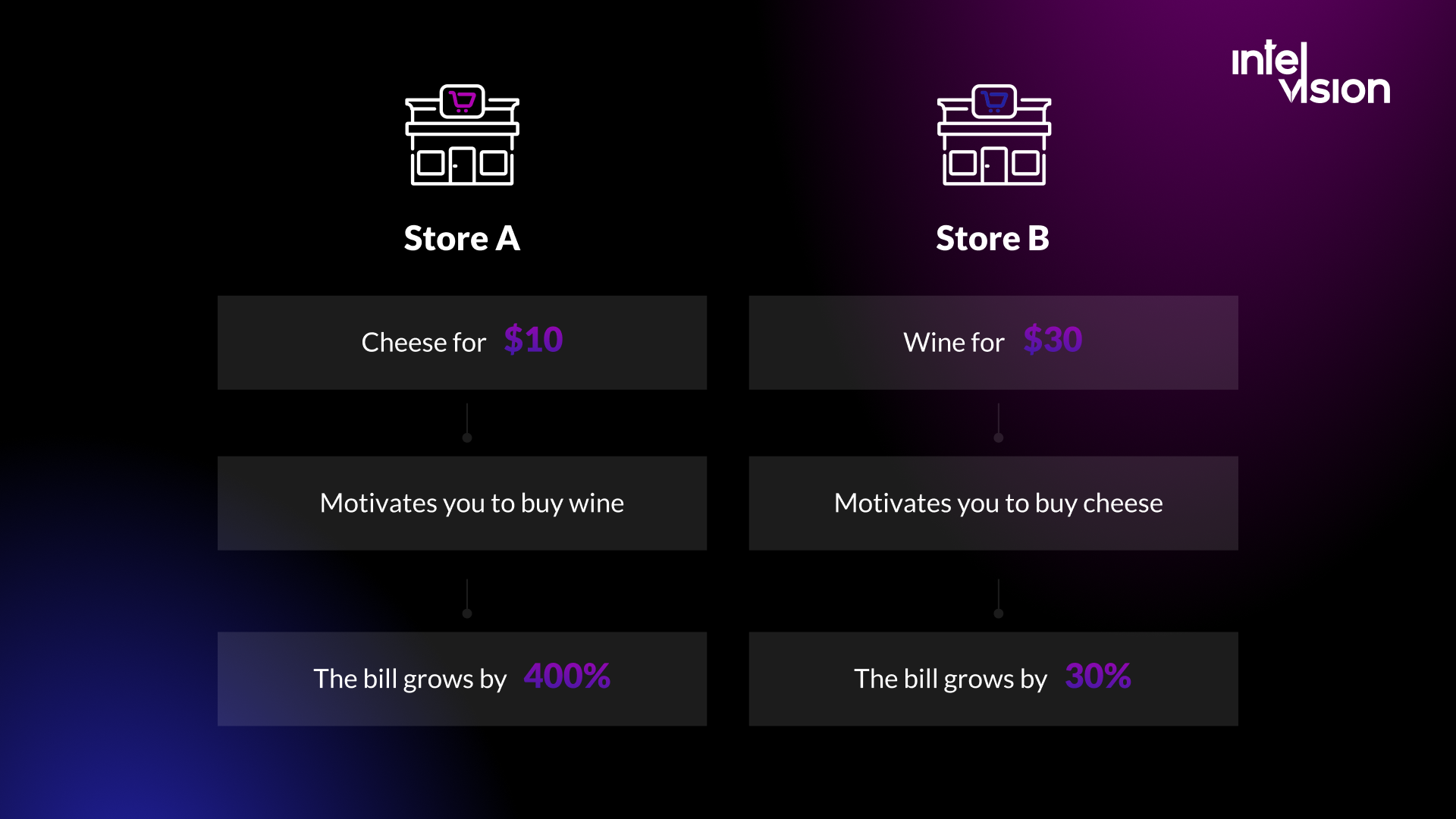


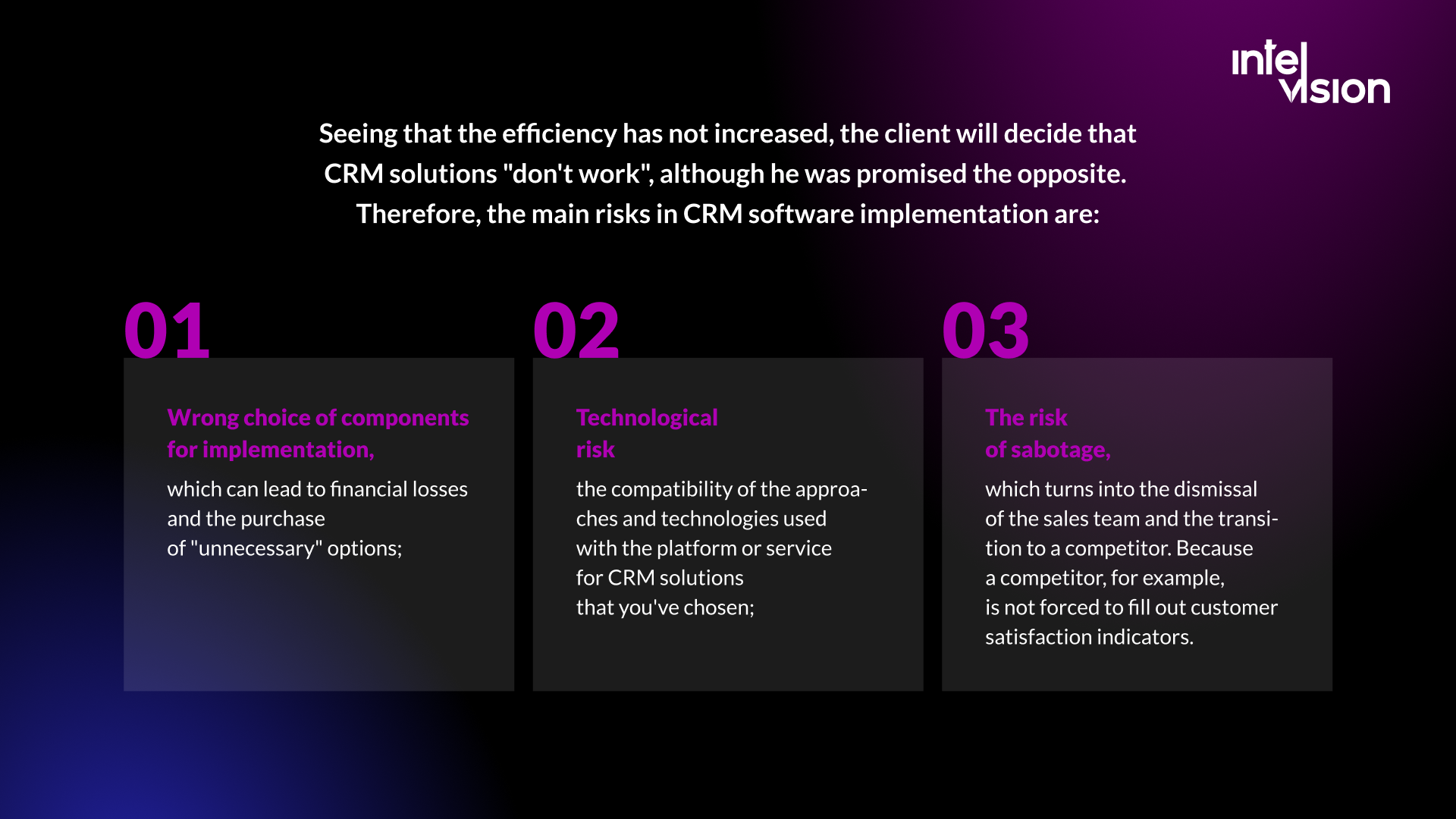

![$portfolio_img_mobile['title'] $portfolio_img_mobile['alt']](https://intelvision.pro/wp-content/uploads/2021/03/Group-892-262x350.png)


